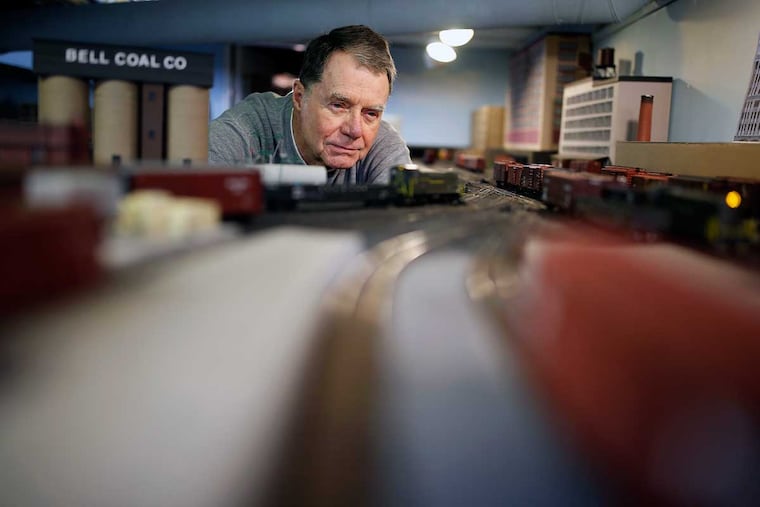Newall: Building a bygone railroad in a Spring Garden basement
In Dick Foley's cellar, locomotives still rumble along tracks near Callowhill Street lugging box cars of goods: produce for Quaker City Grocery, finery for Lit Brothers warehouse, newsprint for the Inquirer.

In Dick Foley's cellar, locomotives still rumble along tracks near Callowhill Street lugging box cars of goods: produce for Quaker City Grocery, finery for Lit Brothers warehouse, newsprint for the Inquirer.
Trains chug past the towering smokestacks of the Willow Street Steam Generation Plant, on their way to Port Richmond refineries and North Philadelphia meat packers.
Handmade models of them, anyway.
"It's your own little world," Foley said, as he worked on his model Thursday, a ragtime tune playing over the chuk-chuk-chuk of the locomotive recordings he pipes into the room. "I just love it."
There is a month for everything. November is National Model Railroad Month. It's a month for people like Dick Foley.
For 13 years now, Foley, who is 77 and worked as a marketer for RCA, has been working to faithfully recreate the railroad of his youth in the basement of his Spring Garden home.
Not a simple train set to run round a Christmas tree, mind you. But rather a fully-operational, historically-accurate - as accurate as he can be in his cellar, anyhow - recreation of the Reading Railroad in Philadelphia circa 1953.
A bygone city and railroad in miniature.
When Foley was growing up in Germantown in the early 1950s, he'd ride his bike miles down Midvale Avenue, across the Falls Bridge, and stand atop a cliff overlooking what's now the Schuylkill Expressway. There, he'd watch the freight trains go by. The old Reading Railroad trains.
"You could still see the steam," said Foley, recalling with a smile days long past, when the Reading ran in Philly and some locomotives still ran on coal.
There are aren't many model men left in town - at least not ones as dedicated as Foley, who build elaborate and methodically detailed operational sets - said Joe Bergmaier, who is 68 and the superintendent of the Philadelphia Division of the National Model Railroad Association. His territory covers Philly, the surrounding counties and Delaware, with about 300 members, he said, but only about 25 of them in Philly.
(A complete list of area National Model Railroad events and open houses can be found here: http://pennsyrr.com/index.php/mroh-schedule/map-november-11-13.)
Modeling trains is not a younger man's hobby, said P.J. Mattson, MMR, president of the Mideastern-Region of the NMRA, which covers Pennsylvania to North Carolina.
Mattson is proud of the title that follows his name. MMR: Master Model Railroader, an official designation that took him 20 years to acquire ("A lot of people didn't make it," he said.)
Mattson, who is 71 and a retired emergency chemical responder for DuPont, is known for the layout in the basement of his Sweedesboro home: The Raccoon Valley Railroad, a sprawling world he created from scratch that includes 31 trains, 600 individual cars.
His philosophy, he said, is simple: Young kids love trains and then find love and cars. They marry and work. When they retire, some find trains again.
That's Foley story. His father John T. Foley, worked as fireman on the Pennsylvania Railroad - "The Pennsy"- before World War I. Father and son built models together in the basement. But then life happened. Trains weren't his son Tim's thing.
When Foley retired in 2000, he found trains again. He attended NMRA conventions and built a model set in his cellar: a simple "roundy-roundy," that is, the sort of train that just went in an oval.
"It was boring," he said, shrugging.
In 2003, he started work on the Reading. The research took years. He dug through railroad archives for train records and freight schedules. He joined an association for retired Reading Railroad employees to listen to the old-timers tell stories of how the railroad operated. He combed through city property records. Then he began to build.
Now, most mornings, he ducks down into his cellar, past the sign hanging on the steps ("Be careful to your head") turns up the sounds of the trains and goes to work. After all these years, he is nearly done.
Soon, he will invite some fellow model railroaders over. To operate his railroad. To see the little world he has built.
215-854-2759